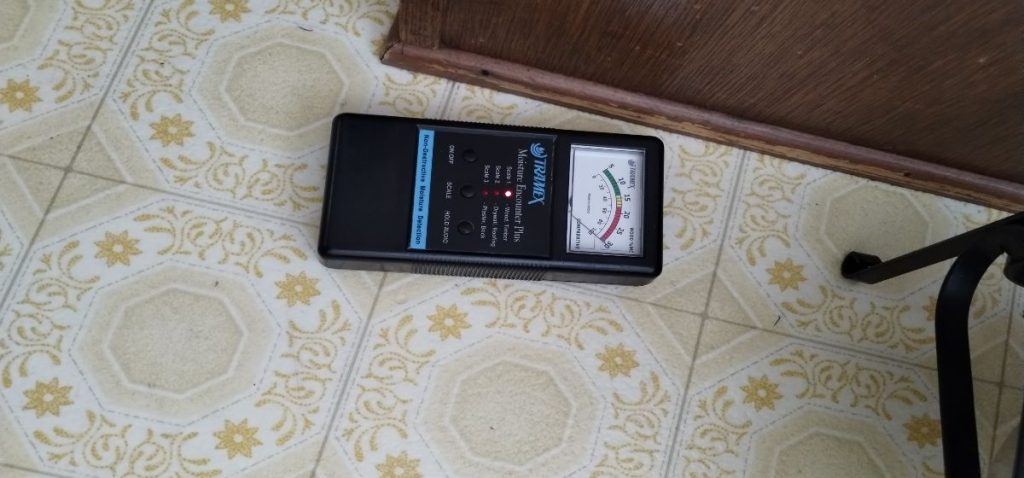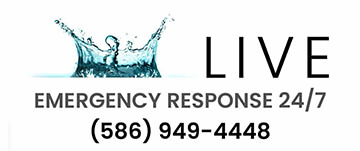
IS YOUR KITCHEN FLOOR WET?
Understanding Wet Kitchen Floor Issues
Kitchen floors of varying materials are a common surface to acquire water damage. Issues resulting from water spills, refrigerator leaks, broken water supply lines and dish washers are fairly common over time. Most kitchen flooring will quickly reveal an issue as water will pool around the source of water intrusion. But are there times when you may have a wet kitchen floor and not see standing water?
The answer is yes! Water that is seen will initiate quick actions to remedy the issue and minimize damage. However, stealthy water can slowly be absorbed into plywood, subfloors and result in permanent damage and mold growth.
Signs you May Have Water Under Kitchen Floor
Finding a wet area on your floor that doesn’t dry out after you soak up the water with a towel, is a cause for concern. If the water issue is left unattended, excessive moisture will do permanent damage as well as introduce harmful mold growth. Here are some common signs water may be trapped beneath your kitchen floor and things are getting worse.
- STICK DOWN VINYL TILES will begin to lift, shift and loosen. In time the wet kitchen floor will become so bad the seams will become noticeably separated and lifted becoming a tripping hazard.
- PLYWOOD SUBFLOORS will swell with moisture making the floor uneven, unlevel and often produce a foul wafting odor that becomes worse with time.
- CERAMIC TILES are the most difficult to identify, but knowing the signs to look for may reveal a problem. When multiple tiles become loose, lifted and cracked with grout pieces breaking, there could be trapped moisture. If the sound of stepping across the floor becomes hollow and dull along with visible water stains showing up, this is even more of an indication you have a wet kitchen floor.
- VINYL PLANK FLOORING will begin to look uneven with seams separating and large gaps appearing. In time the wood plywood subfloor becomes so wet the floor can feel spongy and prominent odors can make the room musty and smell offensive.
- HARD WOOD FLOORING is one of the easiest to recognize as having water damage. Hard wood floors quickly swell with water revealing signs of buckling, cupping with seams lifting making the shape of an Indian teepee. These floors are conspicuous and difficult to walk on without tripping.
- LINOLEUM FLOORS will bubble, lift in the seams and begin to peal away from the corners and edges of the walls.
- CARPETED KITCHEN FLOORS will be wet to the touch, leave footprints when walked on and produce strong musty odors.
2 Ways to Know you Have a Wet Kitchen Floor When you Don’t See Water
These are ways to know you have a wet kitchen floor by observing the signs listed above. Other times water will not be noticeable to the naked eye. These situations require advanced technology to discover. By performing a moisture test you will know for sure if you have a wet kitchen floor requiring drying service.
Employ the Use of a Non-Penetrating Moisture Meter
These instruments send an electromagnetic signal through flooring materials that will easily detect a wet kitchen floor. The higher the signal the closer you are to the source of the water intrusion. These moisture detection meters are affordable and can be found at a local hardware store.
Another option is getting professional help for water damage from a local property restoration firm. Most provide free inspections and use highly advanced moisture detection instruments that homeowners would not be interested in investing in. Their expertise in wet kitchen flooring detection will be valuable in helping locate the source of the water as well as providing a strategy to restore or replace the flooring.
Use a Penetrating Moisture Meter
This moisture meter has two sharp pins that once placed into a material will identify if the materials are wet or dry. These meters only give the moisture content of the materials the pins are directly placed in.
What are the Reasons for a Wet Kitchen Floor?
Once you know you have a wet kitchen floor the next thing to learn is how did it get there. Going through this checklist should reveal the reasons behind kitchen flooring water damage. However, if nothing becomes evident, you may consider contacting the professionals at Action Extraction. We provide free property inspections using scientific technology to help locate difficult to diagnose situations.
- Dish washer malfunction: Check the flooring around the dish washer and check the water supply lines for leaks. Also check the discharge line that connects to the garbage disposal. If these fittings are lose check for water leaks.
- Kitchen sink Issues: A kitchen sink has a hot and cold water supply line that need to be inspected for leaks. Additionally the drain deposits water in the p-trap assembly which needs to be inspected for leaks. Tighten any loose fittings.
- Refrigerator Supply line: Many refrigerators have a supply line for on demand water and ice cubes. If the line becomes kinked, damaged or torn, water will be found on flooring surface around the appliance leaving suspicious water puddles. Water damage from a refrigerator supply line is common as the materials often used by builders is cheap vinyl. If the water line is damaged replace it with a new steel braided supply line and tighten all fittings.
- Water pipe beneath concrete slab: This is a rare cause for a wet kitchen floor, but must be eliminated as a cause with a moisture meter. Kitchens on concrete slabs have the plumbing buried in the concrete. over time through shifting and settling the water pipe can get a small pinhole leak capable of kitchen floor damage.
- Faulty door wall: Door walls require the application of caulk on all seams to keep rain water from infiltrating into the kitchen. Check all the seams around the perimeter of the door wall for missing or compromised sections. Also check into the doors sliding track for water that may be getting in because of a bad door seal itself.
- Roof leak: If you have missing shingles or gutters are not properly managing rain water then water could be dripping into your kitchen walls and being deposited on flooring materials.
- Water from an adjacent room: If your kitchen has a shared wall with a bathroom or laundry room investigate for water related issues. The wet kitchen floor may be receiving water from a loose fitting, supply line leak or faulty sink or toilet.
5 Steps to Dry a Wet Kitchen Floor
Once you have confirmed you have a wet kitchen floor and the source for the damage has been identified, its time to restore or replace flooring. Each flooring requires its own particular technique, but the basic steps we will touch upon. By no means is this an exhaustive delineation for proper flooring restoration. For more detailed information contact the water damage restoration professionals at Action Extraction today and we can provide a detailed analysis for your unique circumstances.
1. Remove top layer of flooring
This is not applicable to hard wood flooring that has not yet buckled and cupped. There are techniques to dry a hardwood floor after a flood that combine vacuum floor mats and thermal energy that professionals use. We are not covering this approach in this article, but instead addressing the hardwood flooring with permanent damage. In that case the first step approach covers all floor types.
Water trapped beneath kitchen flooring requires removal of the top decorative layer to expose the water damaged subfloor. Vinyl tiles and vinyl plank flooring need to be removed and disposed of. Floating wood laminate floors and real hard wood flooring need to be removed as well.
2. Inspect subfloor for mold damage
Once the flooring has been removed, inspect the plywood subfloor for mold growth. Wet plywood will show moisture content by appearing darker than the non-affected areas. Look for suspicious color spots and growths that may be mold. If you uncover mold an alarming amount of mold growth you should consider getting professional help for water damage. Mold remediation is a service requiring stringent guidelines and knowledge to safety mitigate. A do it yourself approach can be like taking a tennis racquet to a hornets nest sending mold spores everywhere making matters worse. If the area of suspected mold growth is small such as under 2 sq. ft. step 3 would apply.
3. Scrub wood subflooring with a cleanser
Wearing a N-95 mask, spray the area with a non-sudsing detergent and scrub vigorously till the natural wood begins to return. Rince with fresh water and a towel or sponge and wipe dry the wet kitchen floor. Apply a germ killing agent liberally and follow step 4.
4. Test the floor for moisture content
Using a wood moisture meter get the reading of the wettest area and compare it to the driest area of flooring. For example if the wet area is 20% and the dry area is 7%, the target goal for drying the wet kitchen floor will be as close to 7% as you can get.
5. Apply air movement with dehumidification
Once you know the difference between the wet and dry subfloor you need to apply air movement. Moving air is an energy that will force moisture out of the wood. The principle for drying is forcing water to become vapor through air movement and dehumidification. Place a fan or several directly on the wet subfloor and setup a dehumidifier in the same room. Monitor the drying progress each day with the moisture meter till drying is complete.
Steps to Prevent Wet Kitchen Floor Damage
Promptly clean floors after a spill
Water routinely gets splashed on kitchen floors when washing hands and loading the dishwasher. Keeping your kitchen floor dry by wiping up any spills keeps water from seeping through micro-cracks and porous surfaces that could affect the subfloor. Even small amounts of water such as from a melted ice cube will over time damage hard wood floors.
Place a rubber back rug in front of kitchen sink
Water from sink use often gets on floors causing damage. Placing a rug or mat in front of the sink can protect the floor from getting wet. This will also reduce the risk of a slip and fall accident. Placing mats and rugs at each door and entryway will keep unwanted water out from wet shoes. Instructing family members to wipe off water when coming in from the wet outdoors will help keep floors clean and dry.
Place towels in walking path when pool with activities
Many homes have swimming pools the family enjoys regularly during the summer months. Kids and friends coming in to use the bathroom or dry off can slip or leave traces of water in walking paths. Placing towels down and removing and replacing with new ones each time swimmers take to the pool will reduce slipping accidents while keeping the kitchen floor dry.
Place a floor fan to dry wet kitchen floor
In the event a large spill from a dishwasher, sink overflow or related water incident occurs, place a floor fan to help with drying. After water is removed with towels or shop vac, there could be moisture still trapped in porous flooring materials. Placing a floor fan for several hours can force water to become vapor and dry the kitchen floor.
Contacting the Professionals may be the right step for managing your wet kitchen floor. Contact the experts at Action Extraction for a free damage assessments of water damaged kitchen floors will help you decide if flooring should be restored or replaced. If your damages merit an insurance claim the good news is homeowners insurance covers kitchen floor water damage restoration and replacement.



